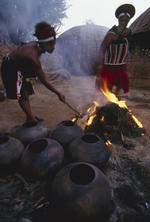
Firing Clay Pots
Easily accessible sources of fuel for the firing of pots have become increasingly scarce due to excessive use of natural resources in over-populated rural communities. Historically, potters gathered the branches of hard fuels in the course of collecting firewood for cooking and for other domestic purposes. In some areas, the dried leaves of aloes have become the primary source of fuel used by potters for the first (bisque) firing of their vessels, but because there has been a tendency to cut down aloes rather than harvest the dried leaves hanging from the bottom of living specimens, potters often have to walk long distances to gather fuel for firing their pots.
Traditionally, coiled pots are rubbed with a stone to achieve a smooth surface before they are fired. Thereafter, potters working in rural KwaZulu-Natal usually follow a two-stage firing procedure. Once pots are cool enough to remove from the fire after the first firing, they are blackened in a second firing. In some cases, discarded tyres are now used to achieve this effect. Increasingly, potters have also taken to using black shoe polish, especially when selling pots to outside buyers. In the past, animal fat was commonly used to wax pots, leaving a rich, shiny glean on finished vessels. It is almost impossible to emulate this effect through the use of industrially manufactured products.
By Professor Sandra Klopper



